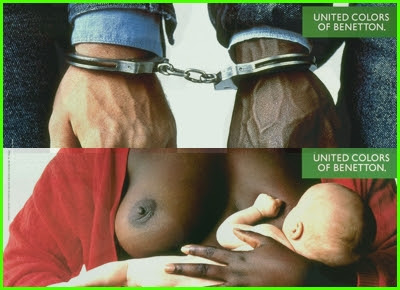But in 1982 they enlisted the help of controversial photographer Oliviero Toscani. The adverts became more about the fun and youthfulness of it and by having so many people from different ethnic backgrounds in the pictures the word colours was meant in more than one way. It celebrated diversity.
The ads continued to play on this concept, and developed the slogan 'United Colors of Benetton'. This eventually became the name of the brand and the brand itself
The adverts then started to divert away from advertising the product and became more about advertising the concept of colours..
This period is the period of time in which Benetton's advertising is, in my opinion, its best. It's clever, playful and funny and compeltley puts across the ethos of the brand without saying much more that 'United Colors of Benetton'.
They then started to become slightly more controversial, playing with taboos and historical contexts..
Not only do the above adverts touch on the taboos of breast feeding and criminality, but they also both in my opinion have implications with the slave trade and the persecution of black Americans during the 1950's. In this time period, it was not uncommon for a white woman to give her baby to the black housemaid to be breastfed. At this point in Benetton's advertising, they are to me still clever and interesting, however less playful and more serious. They started to become even less about the product, and now started to raise awareness for cultural and social issues through their advertising.
During the 80's when the aids epidemic came about, Benetton's clever advertising started to raise mass awareness for the disease. They promoted saftey and precaution with their ads and succeeded in making Aids less of a taboo and something which could be talked about and addressed in society
The above ad still also managed to keep the playful side of Benetton's ethos whilst at the same time promoted a serious message about Aids and other STI's to the public.
However, towards the end of Toscani's partnership with Benetton, the adverts to me became more about causing controversy and exploitation than raising social awareness. Toscani started to use found images, which to me sometimes didn't even have a connection to the brands ethos, for example the below ad which uses the image of a man in his last hours, dieing from Aids. The photograph in its orignal context succeeded in painting the dark serious portrait of Aids and promoting its awareness and seriousness. However when Toscani used the image for Benetton it was turned into colour and for me is just a little sickening. He is at the end of the day, using the image of a dying man and his traumatised family to sell sweaters.
One of Toscani's final ads for Benetton was the one below which caused mass uproar around the world, as it played on something that was very raw at the time and still is today. War effects people so seriously, that for me I don't think it can be used to advertise products, i.e. knitwear
For me, it is such a shame that Benetton's advertising went so downhill. Toscani's advertising throughout the 80's and 90's was to me,genius. It was clever, funny, playful but at the same time helped raise awareness for different issues. From race and gender issues to aids, it gave controversial messages to the public which made them stop and think about Benetton's ads. It made them memorable for the right reasons. However, as Toscani, in my opinion started to lose the plot, it became more about causing controversy and being risky, and for me that risk didn't pay off.







Hi Amy,
ReplyDeleteI was a teenager in the 80s. I remember the ads really well in the all the fashion magazines of the time. They mostly ran in fashion magazines aimed at younger people rather than Vogue, Elle etc.
It seems fairly tame now but at the time, the last two adverts were extremely controversial and nearly ruined the company. It was cynical advertising in order to sell overpriced colourful knitwear.
Jason